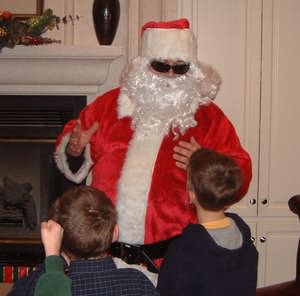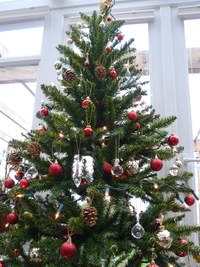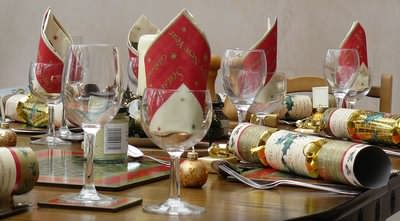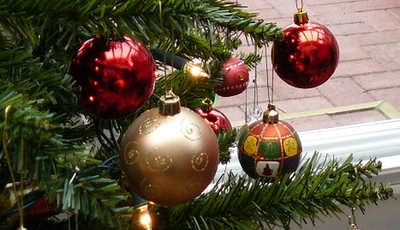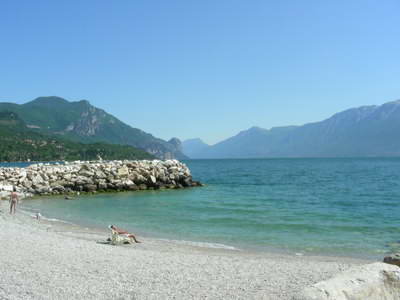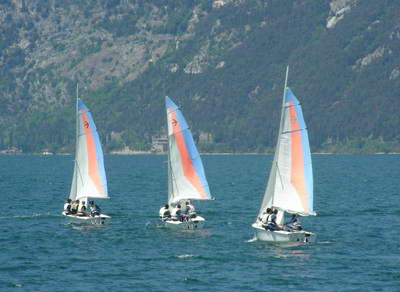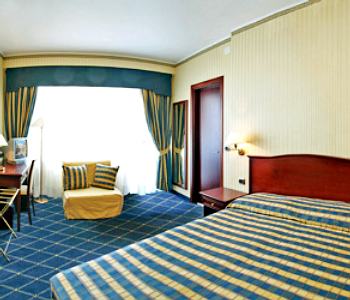| Back to Back Issues Page |
 |
|
LAKE GARDA Newsletter - Special Christmas Edition! December 12, 2011 |
| Hello! Where has the year gone??? Christmas is nearly on us once more and with all that is going on in the world, a few days off to relax and spend time with the family will be wonderful! For the lucky ones who manage to take a holiday at Lake Garda, I wish we could say we'll see you there, but we are off to Canada to see my close family. As you have already probably guessed, if you know much about Italy, Christmas there is not the same as you might find in other countries! If you are expecting a huge turkey and all the trimmings on Christmas day, then you might get a surprise when fish is served instead! As is always the case, Italians are very traditional and like local produce, so you will find local dishes which are traditional to that particular area. That is what makes Italy such a great place for a holiday. It doesn't cater towards mass western tourism, but passionately follows its roots. I hope this never changes as it is one of Italy's most enduring appeals as a holiday destination.
You will find that Christmas eve plays a big part in the Italian calendar with many enjoying a big meal and staying up to see in Christmas day. Traditionally Italians will unwrap their Christmas presents just after midnight, rather than the sleepless night and early morning scramble to wake the parents, as many of us used to enjoy doing as small kids! New Year is also a big deal for the Italians and is probably as important as Christmas to many. It is a large, loud and very social occasion. They see the New Year in by many bangers and fireworks! The streets are full of people and you may as well stay up and enjoy the lively atmosphere, as you probably won't get much sleep anyway!! Our good friend Enzo who lives in Italy, has kindly put together some fascinating details behind the history of Christmas and New Year in Italy. You can read it below - "Christmas Traditions".
We hope you enjoy learning about what this time of year meant to those in times past!
Christmas Traditions "Once, celebrating Christmas was very simple. Most of the population consisted of peasants whose lives during the Christmas season was very different than the rest of the year. There was in fact no working in the fields and therefore you had more time to find, tell and remember things, while sipping a glass of mulled wine. At Christmas eve some of the people would go through the town streets carrying a star, singing and playing shepherd songs while a cart was pushed along holding a flask of wine, which was gradually filled by the most generous. Women on Christmas eve, with much love and joy, prepared Christmas lunch with the simple products of the earth, (chicken, rabbit, potatoes). The men stacked up lots of wood for the fire, ensuring that there was a peice large enough to burn and last throughout Christmas day. Often there was snow, but everyone had to attend the midnight mass. On Christmas Day, euphoric and full of joy, everyone rose early and exchanged greetings, someone brought a gift to the parish priest, such as capon, chicken, or sweets. At noon they were all at table. Lunch was usually frugal: Richer households had tortellini, stuffed capon or chicken and cotechino, but most people were satisfied with just a little milk with polenta. There were no lights, no shop windows with Strenna and luxury gifts, only a few simply decorated trees. In the church there were a few decorations that recalled a mountain village: A simple crib (sprayed with white flour) with a plaster of Jesus, made using lots of moss There would be a cabin and mountains, made of wood logs, paper and leaves, and streets were done with pebbles or yellow flour. The few statuettes were made of plaster and wet paper, small and simple
(now some of these can be found in the antiques markets).
A large bonfire called "buriel" was traditionally done at Christmas."
"Italians had (and still have) a large feast on Christmas Eve. They often strart with eel, and have fish for the main course. The feast is mainly a time of 'affratellamento' (to brethrenise) and friendship. In the oldest folk tradition, the centre of the feast, however, is formed from the strain. The strain would be placed on the hearth up to New Year, in front of the fire. The fire symbolized the sun, which 'consumed' all that bad you had accumulated in the old year, straining it out. In ancient times in Genoa, the strain at Christmas was offered by the Doge of mountain people in a picturesque public ceremony called the beautiful name of "confuoco". The Doge then sprinkled wine on the trunk and confetti between the joy of those present. Some explain the sprinkling of wine with the memory of the blood of Christ. Another method in San Bernardino consisted of using scaled wine thrown against the strain, or used the strain to avoid storms. Both uses are stored in Abruzzo up to modern times. In Puglia the belief was that the strain symbolized the destruction of original sin. At Polena in Abruzzo, they would also burn thirteen small timber "in memory of Christ and the apostles." At Isernia, the head of the house blessed the strain with 'holy water, while family members shout "Jesus is alive!" On Christmas Eve Italians believed that miracles and spells occur, and even serious diseases could be cured on this night. According to an ancient tradition, whoever was born on Christmas Eve became a werewolf, because 'it is reserved for eternity to the birth of Jesus, and who dares to violate it is being punished.' Among the positive beliefs was whoever was drawn to the water fountains at midnight, and in perfect silence ("silent water"), then brought prosperity and wealth. For New Years Eve, a belief ancient and widespread was that all supernatural forces became an extraordinary power, but often only at the 'moment of the beginning' of the year - at midnight sharp. Among those forces included the supernatural luck: and so on the evening of Christmas Eve or New Year's Eve, families would come together and horoscopes were taken. Girls would hope for a future marriage in their horoscopes. This ancient custom has now evolved into the simple pastime of playing bingo...often enjoyed today by families on Christmas Eve or New Years Eve. There are many more ancient beliefs: Italians belived that eating sweets made with almonds or hazelnuts made them more fertile. And the grains of raisins symbolized gold coins."
"Speaking of food, this is what the tradition in the Veneto area is: Around the fireplace on Christmas Eve folk enjoy bigoli in a sauce which start the cenone (big supper). In addition to bigoli, they also have "stropei" which are fried potato dumplings. Then there are various rich dishes ending with the typical "sbrisolona" (an almond tart) or pinza, a cake with dried fruit, grappa brandy and fresh apples. In the Veneto area today, the feast consist of: for starters: various antipasto meats (sausage and soppressata luganeghe), capon broth, risotto with radicchio, and gnocchi with duck sauce. The second course is often polenta and salt cod, boiled beef "in horseradish sauce with mashed potatoes. For the 3rd course: mustard with mascarpone and almond of the Cologna Veneta. Drinks often include a good Amarone della Valpolicella or a good Raboso land of Piave and end with a toast greeting bubbles of Prosecco di Conegliano and Valdobbiadene. In Cadore an ancient tradition is remembered, that of "Pan de la Makaneta." Every family was given about a kilo of bread, accompanied by a slice of ricotta. The custom dates back to 1488 when a certain "donna Maria Machagneti" of Calalo drew up a will in which it was recommended to celebrate every year four masses in her suffrage, then offering a meal to all citizens.
This Tradition lasted until 1907.
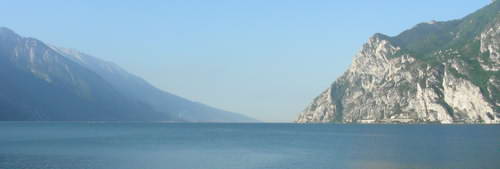
Here is a recipe for a Typical fruit bread, called Zelten (which means 'rare', as it's only made occasionally (usually at Christmas only). The recipe has spread throughout the Trentino Alto Adige region over time, so it is difficult to tell you an exact recipe, as the variety of ingredients change from valley to valley and often from family to family. Zelten Bread INGREDIENTS: 50 grams of sultana raisins; 100 grams of candied orange and citron; 50 g of butter; 4 eggs; 200 grams of icing sugar; 450 grams of white flour; 1 bag (like tea bag) of yeast; 50 grams of pine nuts, 50 grams of peeled almonds; 50 g dates, pitted; 50 g of walnut kernels, 1 dl (100ml) of grappa, a pinch of cinnamon powder, a pinch of cloves powder, 3 tablespoons of milk. Preparation: Butter and a lightly flour a baking dish. In a bowl, marinate sultana raisins and candied fruit in brandy for about an hour. Cut the dates into thin strips. In a small saucepan, bring to boil 1dl (100ml) of water. Melt butter in boiling water, taking care to mix with a wooden spoon. In a bowl work eggs with sugar until you obtain a homogeneous compound (until well mixed). Mix flour and yeast together, and sift. Add the flour & yeast mixture to egg mixture a little at a time, stirring with a wooden spoon. Then pour in the water and butter mixture and stir until well mixed. Finally stir in the sultana raisins and drained candied fruit, the pine nuts, almonds, dates, walnuts, cinnamon, and cloves. with the wooden spoon. Spread the dough to a thickness of 1 cm, or form little loaves if you wish. Place in baking dish & sprinkle with milk. Bake at 180C (350F) for 30 min. Cool before serving." Many Thanks for all your hard work in putting your article together, Enzo! It was so interesting to find out about the Italian traditions surrounding
Christmas! And thanks too for your recipe for Zelten bread...it looks really good and I'll definitely try the recipe out! 
Add your Lake Garda Story to our Website Don't forget to add your stories and comments to our website! Simply go to the forum page which has all the main categories listed (which you can add stories or comments to). We've even added a category for all other stories which don't fit into the main ones listed. So go on, tell everyone about that mouth watering restaurant, amazing shop, adrenalin filled sporting activity, fantastic hotel, your favourite town, and so much more! We can't wait to hear all your stories! Thanks in advance for getting involved in our Lake Garda community. Take a look here at our new
Forums Pages.
Main Events Here are the main events going on in the Lake Garda area over this month and next month. There are also loads of smaller things happening in each town everyday, from art exhibitions to sporting events. Please contact us if you want to know what's going on in any particular town and we'll do our best to help you.
This Issue's Featured Hotel In every newsletter Issue we research and then feature a hotel or apartment at Lake Garda to give you an idea of the accommodation there. We always make sure the hotel has a guest rating of 8 or more (out of 10), so you know it's a decent place to stay! Hotel Benaco is ideally situated in the historic centre of Garda, just 50 meters from Lake Garda and is an ideal base from which to discover the all the charming small towns spread throughout the area. This charming family run hotel is the ideal place to relax and unwind in a peaceful and cosy environment, where the friendly atmosphere and hospitality will make you feel right at home. The Benaco hotel features a cosy lounge area with bar, a breakfast room and a private parking area.
Marcus and Sylvia
|
| Back to Back Issues Page |
